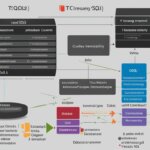Table of Contents
In the world of cloud computing, managing relational databases can be a complex task. That’s where Amazon RDS comes in. Amazon RDS, or Amazon Relational Database Service, is a managed SQL database service provided by Amazon Web Services (AWS). It offers a comprehensive solution for cloud database management, allowing organizations to deploy, operate, manage, and scale relational databases with ease.
As a cloud administrator, you can leverage Amazon RDS to eliminate the hassles of traditional database management. Rather than dealing with the intricate details of setting up and maintaining a database, you can focus on leveraging the power of relational databases to drive your business forward.
With Amazon RDS, you can choose from a variety of database engines, such as MySQL, PostgreSQL, Oracle, and SQL Server, among others. This flexibility allows you to select the engine that best suits your needs and seamlessly migrate your existing databases to the cloud.
Through the intuitive AWS Management Console, API calls, or the Command Line Interface, you can easily control and configure your Amazon RDS instances. The service offers different instance types with varying resource combinations, giving you the flexibility to meet the specific demands of your workload.
Amazon RDS also offers additional features to enhance the management of your relational databases. For example, you can create read replicas for load balancing and high availability, implement automatic failover for increased resilience, and monitor your database performance with Amazon CloudWatch.
Key Benefits:
- Ease of use: Simplify database management tasks with an intuitive interface
- Cost-effectiveness: Pay only for the resources you use, thanks to the pay-as-you-go pricing model
- Scalability: Independently scale compute and storage to accommodate changing business needs
However, it’s important to note that Amazon RDS has some limitations. For instance, it does not provide root access to the underlying server, restricting certain advanced procedures. Additionally, there may be downtime during procedures like patching and scaling, affecting availability temporarily. Considering these factors, it’s crucial to weigh the benefits and drawbacks when deciding to leverage Amazon RDS for cloud database management.
How Does Amazon RDS Work?
Amazon RDS is a managed environment for relational databases in the cloud. It simplifies the deployment, management, and scaling of relational databases, providing organizations with a reliable and efficient solution.
A relational database is a structured system that stores and organizes data points by defining relationships using tables. With Amazon RDS, administrators have multiple options to control and configure their databases according to specific requirements.
There are three primary methods to access and control Amazon RDS:
- The AWS Management Console offers a user-friendly graphical interface for managing database instances. Administrators can easily deploy and configure their databases, as well as monitor performance and set up automated backups.
- Using API calls, administrators can interact with Amazon RDS programmatically. This allows for automation and integration with other systems, making it an efficient method for managing databases at scale.
- The Command Line Interface (CLI) provides a command-based approach to interact with Amazon RDS. Administrators can execute commands and scripts to perform various tasks such as database creation, configuration, and monitoring.
When deploying a database instance on Amazon RDS, administrators can choose from a range of instance types. Each instance type offers different combinations of compute and memory resources to meet specific workload needs. This flexibility allows for optimal performance and cost efficiency.
One key feature of Amazon RDS is replication. Administrators can create read replicas of their databases for load balancing and scaling purposes. These replicas allow for high availability and ensure that the database can handle increased demands without compromising performance.
Amazon RDS also provides a set of powerful features for data migration, backup, recovery, and patching. These features enable organizations to seamlessly migrate their data to Amazon RDS, protect their data with regular automated backups, recover data in case of accidental loss, and keep their database engines up to date with the latest security patches.
Access management is crucial when working with databases, and Amazon RDS offers integration with AWS Identity and Access Management (IAM). Administrators can define specific access permissions for different users, ensuring secure and controlled access to the databases.
In summary, Amazon RDS simplifies the deployment and management of relational databases in the cloud. With its intuitive interfaces, various instance types, replication capabilities, data migration features, and robust access management, it provides organizations with a reliable and scalable solution for their database needs.
Benefits and Drawbacks of Amazon RDS
Managing large relational databases can be complex, but Amazon RDS offers several benefits to organizations grappling with this challenge. By providing a managed SQL database service in the cloud, Amazon RDS simplifies the complexity of database management tasks, eliminating the need to learn and navigate through various tools. Administrators can effortlessly handle multiple database instances using the user-friendly AWS Management Console, allowing for streamlined control and configuration. They also have the ability to automate essential tasks such as backup and recovery, enhancing efficiency and saving time.
When it comes to cost-effectiveness, Amazon RDS is a clear winner. Its pay-as-you-go pricing model ensures that users only pay for the resources they utilize, providing flexibility and eliminating unnecessary expenses. Furthermore, Amazon RDS offers features like read replicas, enabling load balancing and reducing the workload on the main instance. This translates into improved performance and enhanced scalability, allowing organizations to easily accommodate growing demands.
As with any service, there are drawbacks to consider. Root access to the server running Amazon RDS is not provided, limiting the ability to perform certain procedures that require advanced privileges. Additionally, downtime may occur during procedures such as patching and scaling, impacting availability for the duration of these processes. It is crucial to carefully evaluate the benefits and drawbacks of Amazon RDS when considering it for managing relational databases in the cloud.
FAQ
What is Amazon RDS?
Amazon RDS is a managed SQL database service provided by Amazon Web Services (AWS). It allows organizations to deploy, operate, manage, and scale relational databases in the cloud.
How does Amazon RDS work?
Amazon RDS provides a managed environment for relational databases in the cloud. Administrators can control and configure RDS through the AWS Management Console, API calls, or the Command Line Interface. They can deploy database instances, apply specific settings, and perform tasks like data migration, backup, recovery, and patching.
What are the benefits of using Amazon RDS?
Amazon RDS simplifies the complexity of managing databases in the cloud. It offers ease of use, cost-effectiveness, and the ability to scale compute and storage independently. Features like read replicas help in load balancing, and the pay-as-you-go pricing model ensures cost efficiencies.
What are the drawbacks of using Amazon RDS?
There are certain limitations with Amazon RDS, such as lack of root access to the server running RDS and downtime for procedures like patching and scaling. These limitations may restrict certain advanced privileges and affect availability during those periods.







